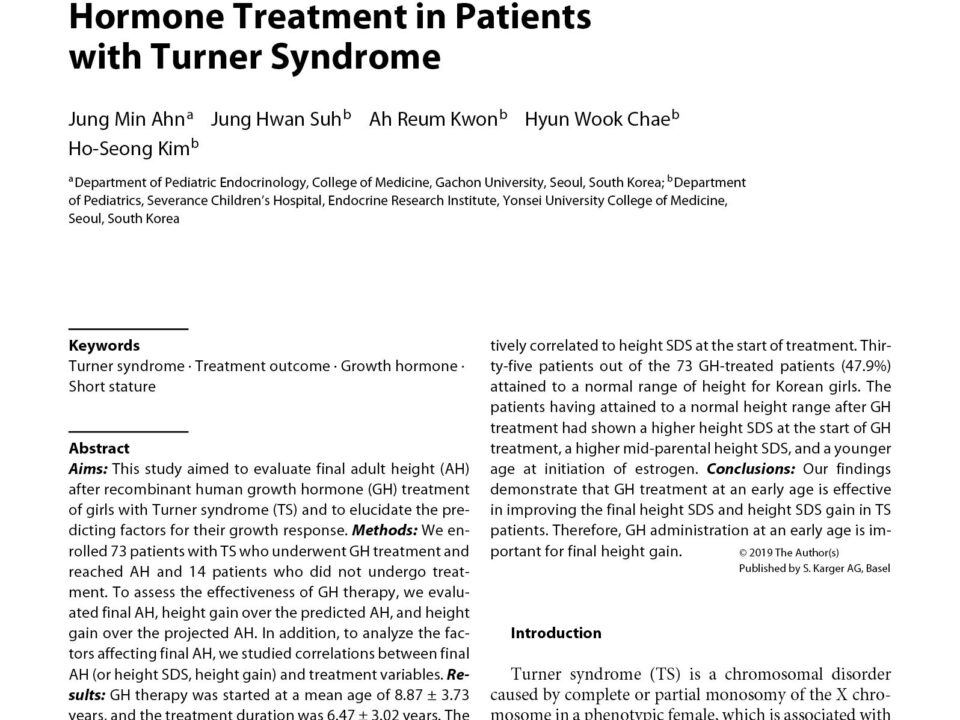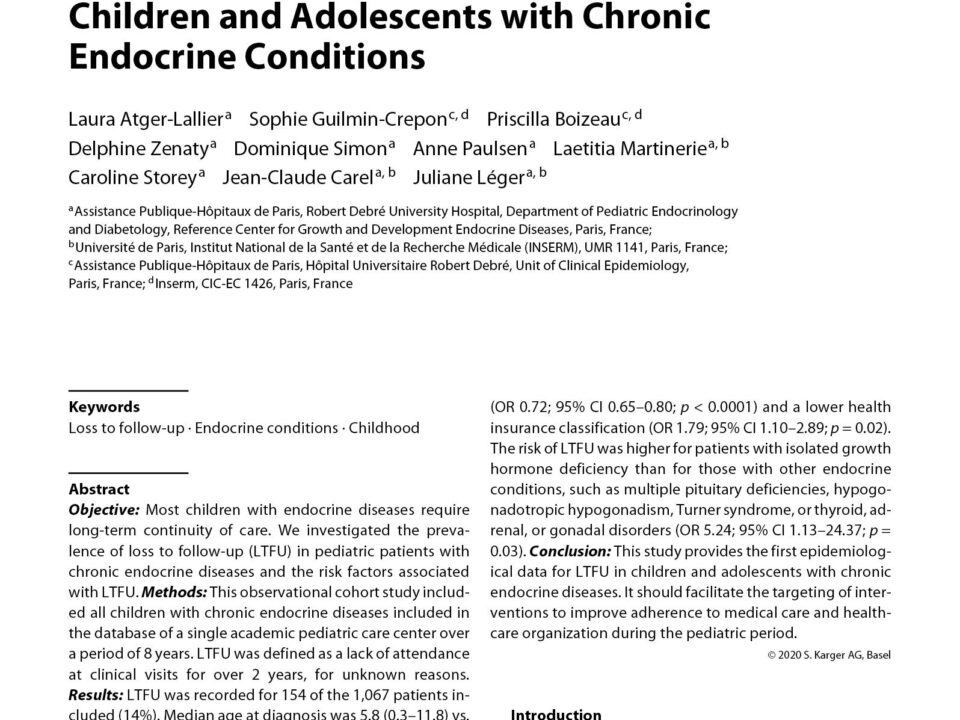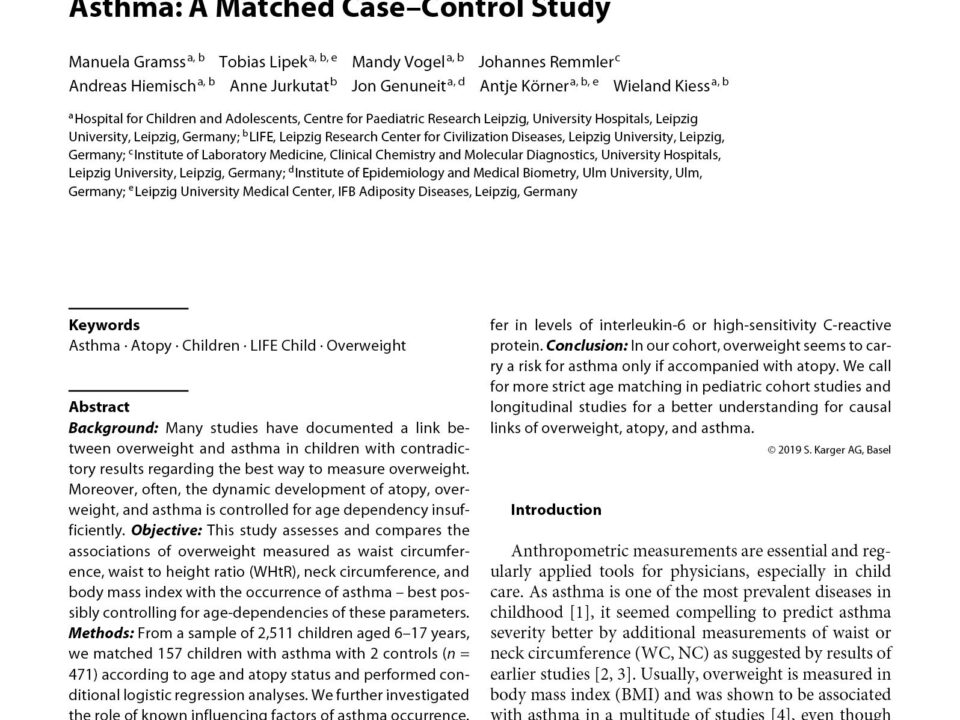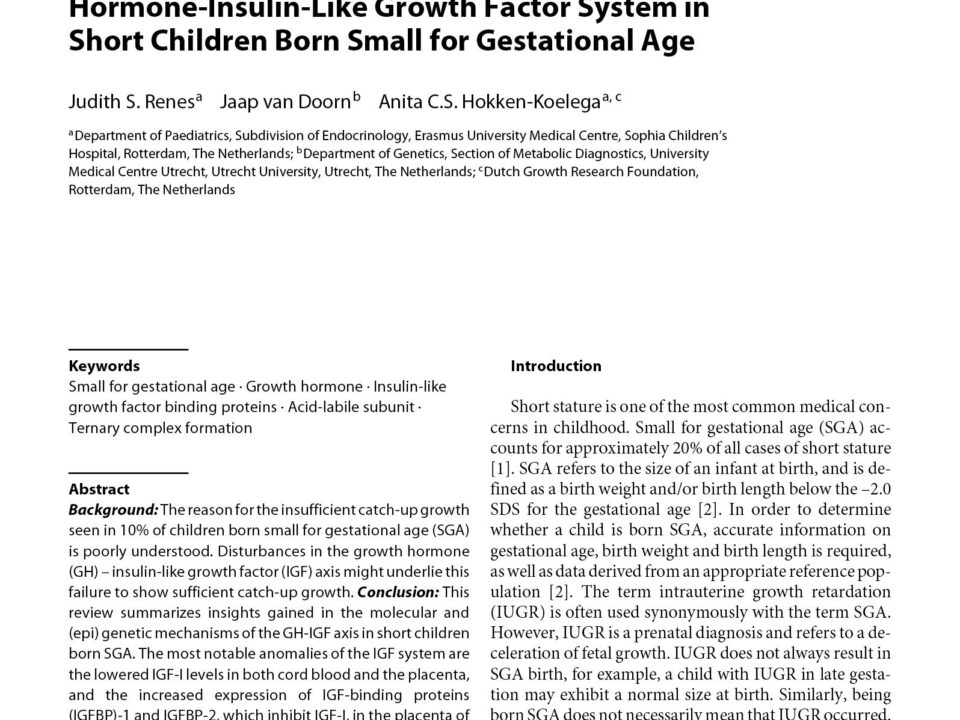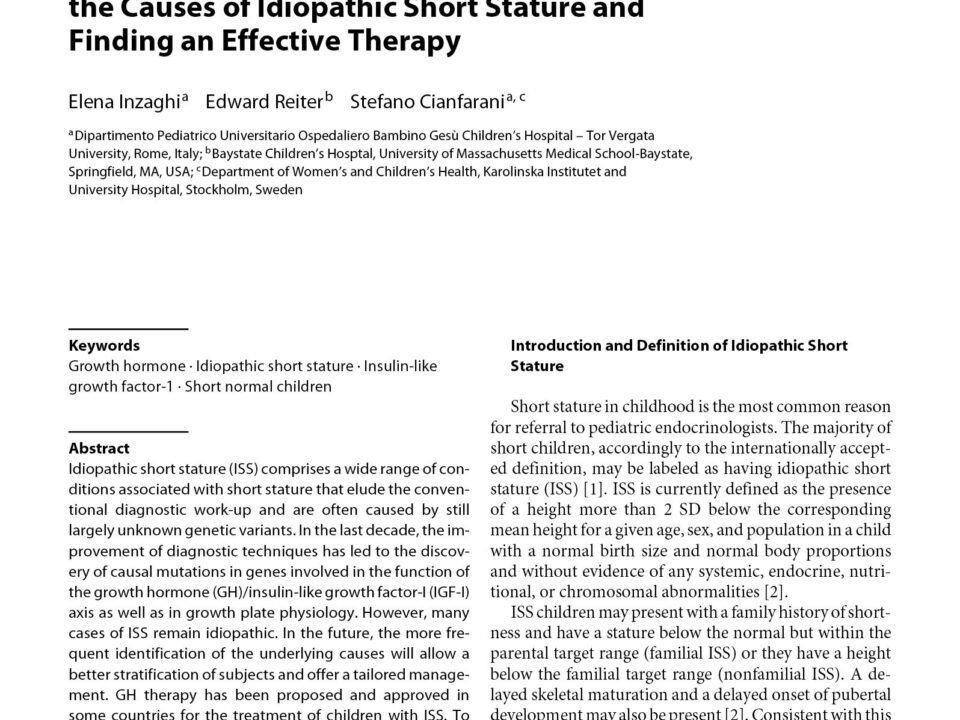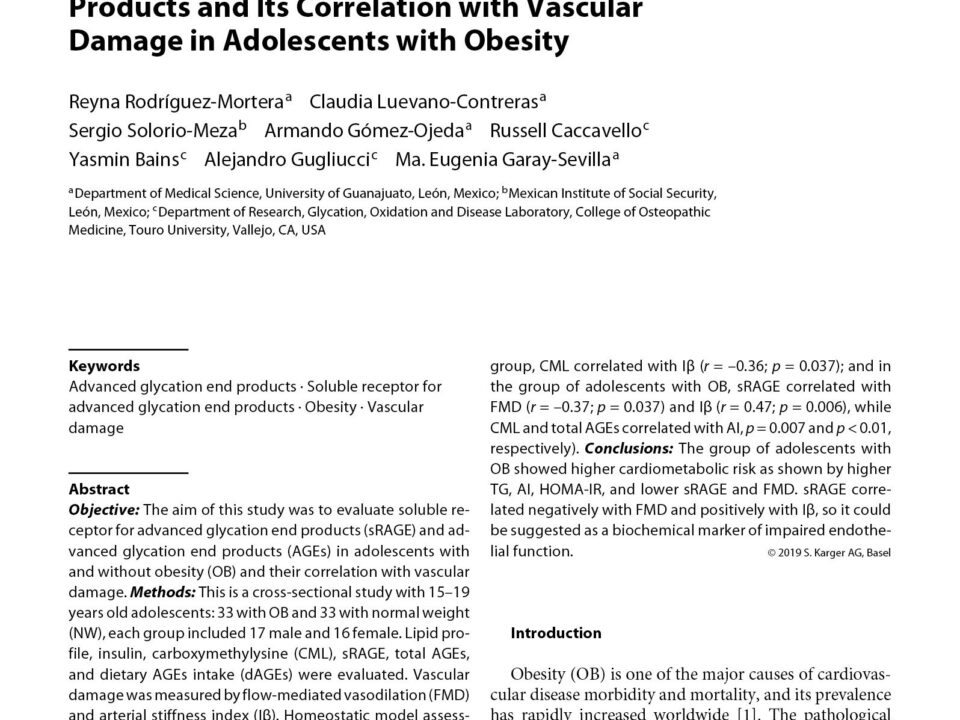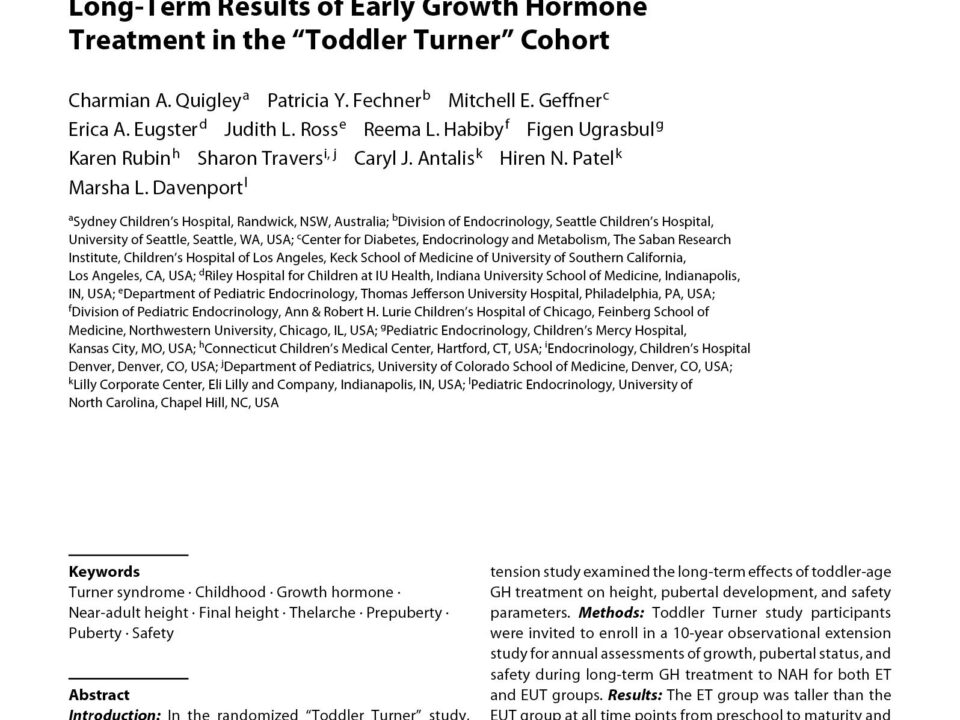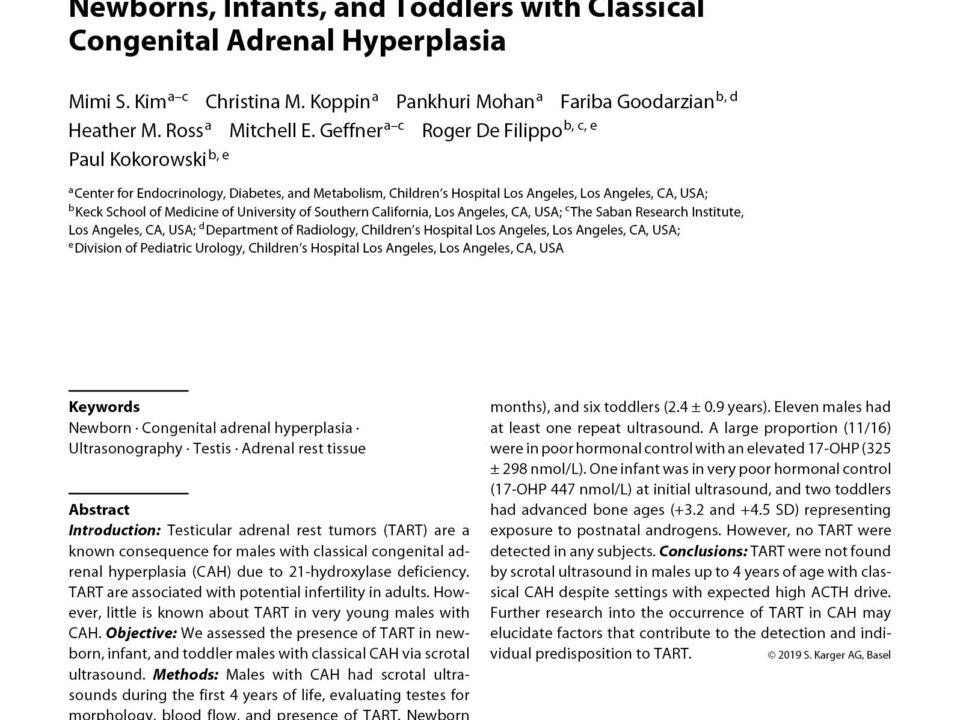December 13, 2022
Aims: This study aimed to evaluate final adult height (AH) after recombinant human growth hormone (GH) treatment of girls with Turner syndrome (TS) and to elucidate the predicting factors for their growth response. Methods: We enrolled 73 patients with TS who underwent GH treatment and reached AH and 14 patients who did not undergo treatment. To assess the effectiveness of GH therapy, we evaluated final AH, height gain over the predicted AH, and height gain over the projected AH. In addition, to analyze the factors affecting final AH, we studied correlations between final AH (or height SDS, height gain) and treatment variables. Results: GH therapy was started at a mean age of 8.87 ± 3.73 years, and the treatment duration was 6.47 ± 3.02 years. The patients in the treated group reached a final AH of 152.03 ± 4.66 cm (final AH SDS for the general population: –1.93 ± 1.03) with a gain over projected AH at the start of treatment of 12.21 ± 4.33 cm. The untreated control subjects had a final AH of 143.57 ± 4.06 cm with a gain over projected AH at the first visit of 3.89 ± 3.80 cm. Final AH and AH SDS were positively correlated to height SDS at the start of treatment. Thirty-five patients out of the 73 GH-treated patients (47.9%) attained to a normal range of height for Korean girls. The patients having attained to a normal height range after GH treatment had shown a higher height SDS at the start of GH treatment, a higher mid-parental height SDS, and a younger age at initiation of estrogen. Conclusions: Our findings demonstrate that GH treatment at an early age is effective in improving the final height SDS and height SDS gain in TS patients. Therefore, GH administration at an early age is important for final height gain.
December 13, 2022
Objective: Most children with endocrine diseases require long-term continuity of care. We investigated the prevalence of loss to follow-up (LTFU) in pediatric patients with chronic endocrine diseases and the risk factors associated with LTFU. Methods: This observational cohort study included all children with chronic endocrine diseases included in the database of a single academic pediatric care center over a period of 8 years. LTFU was defined as a lack of attendance at clinical visits for over 2 years, for unknown reasons. Results: LTFU was recorded for 154 of the 1,067 patients included (14%). Median age at diagnosis was 5.8 (0.3–11.8) vs. 1.2 (0.0–6.9) years, and age at last visit was 14.1 (9.7–16.1) vs. 11.7 (6.1–15.8) years, for the LTFU and no-LTFU groups, respectively. In multivariate analysis, the risk of LTFU increased with age at diagnosis (OR 1.18; 95% CI 1.12–1.24) and was higher for patients diagnosed before 2006 (vs. after 2006; OR 4.80; 95% CI 3.00–7.66), with fewer visits in the last 3 years (OR 0.72; 95% CI 0.65–0.80; p < 0.0001) and a lower health insurance classification (OR 1.79; 95% CI 1.10–2.89; p = 0.02). The risk of LTFU was higher for patients with isolated growth hormone deficiency than for those with other endocrine conditions, such as multiple pituitary deficiencies, hypogonadotropic hypogonadism, Turner syndrome, or thyroid, adrenal, or gonadal disorders (OR 5.24; 95% CI 1.13–24.37; p = 0.03). Conclusion: This study provides the first epidemiological data for LTFU in children and adolescents with chronic endocrine diseases. It should facilitate the targeting of interventions to improve adherence to medical care and healthcare organization during the pediatric period.
December 13, 2022
Background: Many studies have documented a link between overweight and asthma in children with contradictory results regarding the best way to measure overweight. Moreover, often, the dynamic development of atopy, overweight, and asthma is controlled for age dependency insufficiently. Objective: This study assesses and compares the associations of overweight measured as waist circumference, waist to height ratio (WHtR), neck circumference, and body mass index with the occurrence of asthma – best possibly controlling for age-dependencies of these parameters. Methods: From a sample of 2,511 children aged 6–17 years, we matched 157 children with asthma with 2 controls (n = 471) according to age and atopy status and performed conditional logistic regression analyses. We further investigated the role of known influencing factors of asthma occurrence. Results: In children with atopy, all overweight proxies were consistently positively associated with asthma. Statistical significance was reached for WHtR-SD score (OR 1.26, 95% CI 1.03–1.54, p = 0.025) and persisted when further covariates, such as birth weight or social status, were added to the model. Groups of atopic versus nonatopic participants do not differ in levels of interleukin-6 or high-sensitivity C-reactive protein. Conclusion: In our cohort, overweight seems to carry a risk for asthma only if accompanied with atopy. We call for more strict age matching in pediatric cohort studies and longitudinal studies for a better understanding for causal links of overweight, atopy, and asthma.
December 13, 2022
Background: The reason for the insufficient catch-up growth seen in 10% of children born small for gestational age (SGA) is poorly understood. Disturbances in the growth hormone (GH) – insulin-like growth factor (IGF) axis might underlie this failure to show sufficient catch-up growth. Conclusion: This review summarizes insights gained in the molecular and (epi) genetic mechanisms of the GH-IGF axis in short children born SGA. The most notable anomalies of the IGF system are the lowered IGF-I levels in both cord blood and the placenta, and the increased expression of IGF-binding proteins (IGFBP)-1 and IGFBP-2, which inhibit IGF-I, in the placenta of SGA neonates. These observations suggest a decreased bioactivity of IGF-I in utero. IGF-I levels remain reduced in SGA children with short stature, as well as IGFBP-3 and acid-labile subunit levels. Proteolysis of IGFBP-3 appears to be increased.
December 13, 2022
Idiopathic short stature (ISS) comprises a wide range of conditions associated with short stature that elude the conventional diagnostic work-up and are often caused by still largely unknown genetic variants. In the last decade, the improvement of diagnostic techniques has led to the discovery of causal mutations in genes involved in the function of the growth hormone (GH)/insulin-like growth factor-I (IGF-I) axis as well as in growth plate physiology. However, many cases of ISS remain idiopathic. In the future, the more frequent identification of the underlying causes will allow a better stratification of subjects and offer a tailored management. GH therapy has been proposed and approved in some countries for the treatment of children with ISS. To improve the efficacy of GH therapy, trials with GH combined with GnRH agonists, aromatase inhibitors, and even IGF-I have been conducted. This review aims to revise the current definition of ISS and discuss the management of children with ISS on the basis of the most recent evidence.
December 13, 2022
Objective: The aim of this study was to evaluate soluble receptor for advanced glycation end products (sRAGE) and advanced glycation end products (AGEs) in adolescents with and without obesity (OB) and their correlation with vascular damage. Methods: This is a cross-sectional study with 15–19 years old adolescents: 33 with OB and 33 with normal weight (NW), each group included 17 male and 16 female. Lipid profile, insulin, carboxymethylysine (CML), sRAGE, total AGEs, and dietary AGEs intake (dAGEs) were evaluated. Vascular damage was measured by flow-mediated vasodilation (FMD) and arterial stiffness index (Iβ). Homeostatic model assessment-insulin (HOMA-IR) and atherogenic index (AI) were calculated. Results: The group with OB had higher triglycerides (TG; p < 0.0001), AI (p < 0.001), HOMA-IR (p < 0.0001), dAGEs intake (p < 0.0001), lower CML (p = 0.05), total AGEs (p < 0.01), sRAGE (p < 0.001), and FMD (p < 0.002). In the total group, sRAGE correlated with AI (r = –0.26 p = 0.037); in the NW group, CML correlated with Iβ (r = –0.36; p = 0.037); and in the group of adolescents with OB, sRAGE correlated with FMD (r = –0.37; p = 0.037) and Iβ (r = 0.47; p = 0.006), while CML and total AGEs correlated with AI, p = 0.007 and p < 0.01, respectively). Conclusions: The group of adolescents with OB showed higher cardiometabolic risk as shown by higher TG, AI, HOMA-IR, and lower sRAGE and FMD. sRAGE correlated negatively with FMD and positively with Iβ, so it could be suggested as a biochemical marker of impaired endothelial function.
December 13, 2022
Background/Aims: Thyroid hormones (TSH) play a key role in the working of the cardiovascular system, with direct effects on cardiac function, vascular system, and atherosclerotic factors. Epicardial adipose tissue, the visceral fat of the heart, has emerged as a new cardiometabolic risk marker because of its close anatomical proximity to the myocardium and coronary artery. This study aimed to evaluate epicardial fat thickness (EFT) in children with subclinical hypothyroidism (SH) and its relation to early atherosclerotic changes. Methods: The study included 32 children with SH due to autoimmune thyroiditis and 32 healthy children matched for age and gender as control group. Patients and controls underwent anthropometric evaluation and measurement of fasting lipids, glucose, insulin, homeostasis model assessment for insulin resistance and high-sensitivity C-reactive protein (hs-CRP). TSH, free thyroxine (FT4 and FT3) and antithyroid autoantibodies (antithyroid peroxidase and thyroglobulin antibodies) were also measured. Conventional echocardiography was used to assess EFT. Noninvasive ultrasound was used to measure carotid intima-media thickness and brachial artery flow-mediated dilation (FMD) responses. Results: Compared to controls, patients had higher atherogenic index (AI) and hs-CRP (p = 0.001 for each). Conventional echocardiography revealed that patients with SH had higher EFT (p = 01) and significantly lower FMD response compared with the control (p = 0.001). In multivariate analysis, EFT values were significantly correlated with TSH (OR 1.2; 95% CI 1.04–1.34; p = 0.01), hs-CRP (OR 1.1; 95% CI 1.09–1.14; p = 0.001, AI (OR 1.6; 95% CI 1.17–2.03; p = 0.001), and FMD response (OR 2.4; 95% CI 1.14–2.53; p = 0.01). Conclusions: Our study demonstrated that EFT is higher in children with SH compared with controls and associated with FMD responses. Measurement of EFT by echocardiography in children with SH may help to identify those at high risk of developing subclinical atherosclerosis.
December 13, 2022
Background: Girls with Turner syndrome (TS) have a high incidence of primary ovarian insufficiency. Recent data show rates of spontaneous thelarche (ST) of 38% and spontaneous menarche (SM) of 15–16%, with higher rates in those with mosaicism. Summary: We systematically reviewed the literature for evidence regarding rates of ST and SM in TS and evaluated rates based on the type of chromosomal mosaicism. We searched MEDLINE via PubMed, Embase, and the Cochrane Database of Controlled Trials. Reference lists were screened. Studies reporting outcomes of ST and SM in girls with TS, diagnosed by genetic analysis, were included. Data was collected regarding study design, cohort type, cohort age, the number of participants with ST and SM, the individual age at diagnosis of ST and SM, the mean age of patients with ST and SM, sample size, the number of participants with secondary amenorrhea, and karyotype. Key Messages: In total 2,699 patients were assessed for ST and 2,890 for SM from 43 articles. Overall the rates of ST were 32% (95% CI 26.4–38.9) and SM 20.8% (95% CI 19.3–22.4). Girls with X monosomy had the lowest rates of ST (i.e., 13%; 95% CI 8.7–19.7) and SM (i.e., 9.1%; 95% CI 7.3–11.3). Girls with 45,X/47,XXX had the highest rates of ST (i.e., 88.1%; 95% CI 62–97.1) and SM (i.e., 66.2%; 95% CI 49.3–79.6). Conclusions: Rates of ST and SM differ by karyotype in TS. When counseling patients, the karyotype should strongly influence discussions regarding pubertal development and the future reproductive potential.
December 13, 2022
Introduction: Testicular adrenal rest tumors (TART) are a known consequence for males with classical congenital adrenal hyperplasia (CAH) due to 21-hydroxylase deficiency. TART are associated with potential infertility in adults. However, little is known about TART in very young males with CAH. Objective: We assessed the presence of TART in newborn, infant, and toddler males with classical CAH via scrotal ultrasound. Methods: Males with CAH had scrotal ultrasounds during the first 4 years of life, evaluating testes for morphology, blood flow, and presence of TART. Newborn screen 17-hydroxyprogesterone (17-OHP) and serum 17-OHP at the time of ultrasound were recorded. Bone ages were considered very advanced if ≥2 SD above chronological age. Results: Thirty-one ultrasounds in 16 males were performed. An initial ultrasound was obtained in four newborns at diagnosis (6.8 ± 2.1 days), six infants (2.2 ± 0.9 months), and six toddlers (2.4 ± 0.9 years). Eleven males had at least one repeat ultrasound. A large proportion (11/16) were in poor hormonal control with an elevated 17-OHP (325 ± 298 nmol/L). One infant was in very poor hormonal control (17-OHP 447 nmol/L) at initial ultrasound, and two toddlers had advanced bone ages (+3.2 and +4.5 SD) representing exposure to postnatal androgens. However, no TART were detected in any subjects. Conclusions: TART were not found by scrotal ultrasound in males up to 4 years of age with classical CAH despite settings with expected high ACTH drive. Further research into the occurrence of TART in CAH may elucidate factors that contribute to the detection and individual predisposition to TART.
